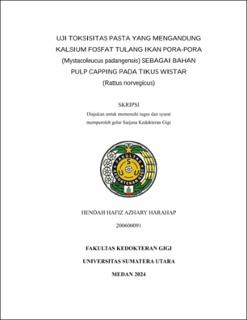| dc.description.abstract | The formation of a dentinal bridge is an indicator of success of direct pulp capping treatment. The material that is widely used in direct pulp capping treatments is calcium hydroxide, but in the long term calcium hydroxide does not provide good results on dentin and a very high pH can cause necrosis of the pulp tissue. Pora-pora fish bones can be used as an alternative material for pulp capping due to the high calcium phosphate content, but safety needs to be ensured. This study aims to determine the results of toxicity tests and the safe dosage of pora-pora fish bone that contains calcium phosphate paste as a pulp capping material in Wistar rats.This research is an experimental post test only control group design in vivo. This study used 25 mice divided into 5 treatment groups, namely the negative control group, the 1 mg, 8.5 mg, 60 mg, 400 mg dose groups. The paste was applied orally and observed for 2 weeks to observe changes in behavior, changes in body weight, and observation of the weight of the kidney organs. Changes in behavior were observed visually, while data on changes in body weight were analyzed using the Kruskall-Wallis test and observations of kidney organ weight were analyzed using the One-Way Anova test.The results of statistical tests stated that there were no significant differences in changes in body weight of wistar rats and kidney organ weight in each treatment group (p>0.05). Apart from that, there were no changes in behavior during observation at doses of 1 mg, 8.5 mg, 60 mg, 200 mg. It can be concluded that pora-pora fish bone calcium phosphate paste with a concentration of 75% is not toxic and safe to use as a pulp capping material. | en_US |


